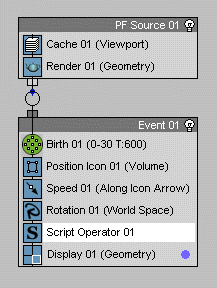Metaball Sample Script
Description:
The following example shows a sample Metaball script using the Parray particle system.
Can Be Used With:
Should be used in a Script_Operator.
Effect:
In the Proceed handler, a new Mesh object is created with a vertex at each particle.
Then, a PArray classical particle system is created and used to generate a metaball
mesh out of all vertices of the supplied mesh. Now, using a Mesher compound object,
a snapshot of the metaball is made and used as the shape of the first particle.
| EXAMPLE
|
--The ChannelsUsed handler defines the channels
--to be made available to the script.
--For the list of all channels, see
--Interface: MaxscriptParticleContainer
--The parameter pCont passed to the handler
--contains the Particle Container the script is applied to
on ChannelsUsed pCont do
(
pCont.usePosition = true
pCont.useTime = true
pCont.useSpeed = true
pCont.useShape = true
)
--The Init handler is called on initialization.
--It is not used in this case.
on Init pCont do
(
)
on Proceed pCont do
(
--Get the start and end times
t1 = pCont.getTimeStart() as float
t2 = pCont.getTimeEnd() as float
--As long as there are particles
if (pCont.NumParticles() > 0) then
(
--Disable screen redraws to keep speed up
with redraw off
(
-- create an empty mesh
nMesh = editable_mesh()
-- Set the number of vertices and faces to the
-- number of particles.
nMesh.numVerts = pCont.NumParticles()
nMesh.numFaces = pCont.NumParticles()
--We will make a single vertex for each particle
for i in 1 to pCont.NumParticles() do
(
-- Time for the particle to travel at this integration step
timeStep = t2 - (pCont.getParticleTime(i) as float)
-- Speed is added to foresee the particle position at the end
-- of the integration step
nMesh.verts[i] = pCont.getParticlePosition(i) + timeStep * pCont.getParticleSpeed(i)
-- The face references the same vertex 3 times!
nMesh.faces[i] = [i,i,i]
)
-- create PArray with particles on vertices of the mesh
a = PArray()
a.speed = 0
a.formation = 2-- at all vertices
a.quantityMethod = 1--use Total
a.Total_Number = 1--just initializing
a.viewPercent = 100
a.Emitter_Start = 0f
a.Emitter_Stop = 0f
a.subsampleCreationTime =off
a.Display_Until = 2000f
a.life = 2000f
a.Growth_Time = 0f
a.Fade_Time = 0f
a.particleType = 1--metaballs
a.metaballAutoCoarsness =off
a.metaballRenderCoarsness = 0.9
a.metaballViewCoarsness = 0.9
a.Metaparticle_Tension = 1.0
a.size = 5
a.Total_Number = pCont.NumParticles()--use particles count
a.emitter = nMesh
-- acquire the metaball mesh from the PArray
mshr = mesher() --create a Mesher Compound object
mshr.pick = a --get the PArray
metaballMesh = snapshot mshr --make a snapshot of the Mesher
delete a --delete the PArray
delete #(mshr, nMesh) --delete the Mesher and our mesh
-- speed is added to foresee the particle position at the end
-- of the integration step
timeStep = t2 - (pCont.getParticleTime(1) as float)
spaceOffset = pCont.getParticlePosition(1) + timeStep * pCont.getParticleSpeed(1)
-- adjust vertex location to center around the first particle
for i in 1 to metaballMesh.verts.count do
( move metaballMesh.verts[i] (-spaceOffset) )
--Create an empty mesh to assign to all particles
emptyMesh = editable_mesh()
--Assign the empty mesh to all particles.
--This makes them invisible
pCont.setShapeForAllParticles(emptyMesh.mesh)
--First particle carries all the mesh data
pCont.setParticleShape 1 metaballMesh.mesh
--Delete the empty mesh and the snapshot
delete #(emptyMesh, metaballMesh)
)
)
)
--The Release handler is used to do cleanup work.
--Not used in this case.
on Release pCont do
(
)
|



